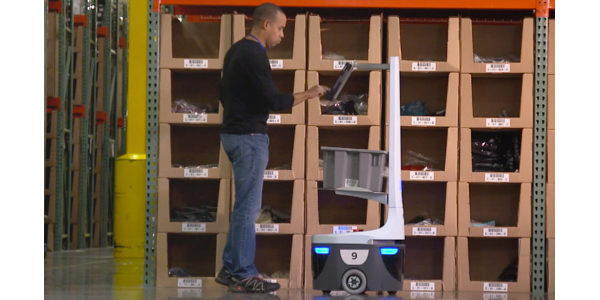Fewer restrooms, more charging stations: How robots will transform the warehouse

The rise of robotics is one of the fastest-growing trends in logistics, with announcements of warehouses that have invested in robots or autonomous vehicles coming almost weekly. Distribution center managers are now using robotics and advanced automated equipment to solve challenges at every stage of the material handling game.
But how exactly will all these new bots fit into the typical DC? In their rush to forge a robotic link in the supply chain, planners are still trying to predict what sort of buildings and infrastructure they will need to support the complex machines.
A century ago, architects wrestled with a similar issue when the industrial revolution brought widescale changes to residential housing design. Now that most people commute by automobile instead of horseback, modern homes have attached two-car garages instead of hay barns and stables.
So will the warehouses of 2050 look different because they're designed to accommodate squadrons of robots instead of shifts of human workers? (After all, robots don't need restrooms, but they might need extra electrical outlets.) In fact, warehouse design is already evolving to accommodate robots' needs, and experts say that a few simple changes can make all the difference.
THE BIG EMPTY BOXThe easiest way to go robotic is to start from scratch, incorporating any required features like charging stations, Wi-Fi networks, and smooth floors into the design of a brand-new building, says Doug Rabeneck, director in the operations excellence practice at business and technology consulting firm West Monroe Partners. That approach is clearly more expensive than adding robotics to an existing warehouse, but it avoids the challenges of overlaying a new robotic system onto the existing work force and systems.
Despite the expense, that approach was common 20 years ago, when early generations of automated guided vehicles (AGVs) required wire-guided controls buried in cement warehouse floors so the vehicles could follow predetermined routes like streetcars moving through a city, Rabeneck says.
More recent offerings—such as the robots developed by Amazon Robotics, Clearpath Robotics, and Locus Robotics—require less infrastructure, using unobtrusive technologies like "lidar" and vision systems for navigation instead of relying on permanent hardware like wires, magnets, or beacons. Thanks to those advances, companies are finding it easier to add robots to a warehouse, whether the building is new or old.
"Your building just needs to be a big empty box," Rabeneck says. "To retrofit it, you might need a lot of electronics and communications up on the roof, like wireless router boxes, and either a server in one corner of the facility or communications through the cloud. And you'd probably need charging stations for the units."
GETTING ROBOT-READYIn addition to wiring a building with advanced charging and communications systems, several basic details in the design and layout of a facility can affect its readiness to host material handling robots, says Tom Galluzzo, founder and CEO of Pittsburgh-based Iam Robotics.
"The name of the game is optimizing a solution to whatever your goal is, whether that's an each-picking solution or [one where machines] collaborate with the work force," Galluzzo says. But the needs of people aren't always aligned with those of the machines, he says. "For example, people usually like working in a temperature of 70 degrees, whereas robots might want it to be 50 degrees. If you're going to use both manual and robotic solutions, you need a happy medium."
Even interior design can affect the choice of robotics. For instance, people will gladly walk around on carpeting all day, but robots don't like carpets, Galluzzo says.
"We look for pristine, bare, flat concrete floors," says Galluzzo. "We've been in places with hundred-year-old wooden floors and they're really beat up. To drive robots on that would be like driving your car on cobblestones all day long."
The layout of a DC is also important, since most robots need to be insulated from the elements, not operating anywhere near a loading dock where rain or snow could blow in and affect their electronics, he says.
Finally, just as any building has features dedicated to its human workers' needs—such as a soda machine or a break room—a warehouse designed for robots would need its own "amenities." For instance, an automated DC design could call for a reinforced power grid to handle the extra charging stations and a redundant electric generator so the building doesn't shut down every time a storm knocks the power out.
Safety is another crucial consideration in a robotic fulfillment facility. Recent laptop and smartphone recalls have highlighted the potential for lithium-ion batteries to overheat and even spark fires. A lot of robots today use similar lithium-ion battery technology, which not only raises the question of fire safety but also has implications for operations where DC workers are trained to safely handle the lead-acid batteries commonly used in forklifts but not their lithium-ion counterparts.
"Lithium-ion batteries need a little more care and maintenance than lead-acid," Galluzzo says. "Because you have all that energy density [with lithium-ion], you need to be sure you have your safety precautions in line, like fire safety. What it comes down to is that you're storing more energy in a smaller package."
To address that issue and create a safer working environment, engineers are already working on a next generation of batteries designed for long life and safe operation. The new designs use lithium iron phosphate (LiFePO4) cHemiätry instead of the current lithium polymer designs, Galluzzo says.
BOOSTING STORAGE DENSITYOnce a warehouse has satisfied those basic design requirements, it might start to look a lot different inside, as the introduction of robots tends to change inventory storage patterns. A warehouse with automated storage and retrieval systems (AS/RS), for instance, can pack more inventory into a given space than one that relies on human pickers, since computer-guided retrieval vehicles can easily navigate aisles with just an inch or two of clearance, Rabeneck says.
Similarly, many goods-to-person robotic systems allow for higher-density storage than a warehouse that has to leave aisles between racks for human pickers or forklifts. But some of that advantage is lost if the bots also need a dedicated staging area to place racks of products, which can be the case in operations that use robots to deliver racks of products to a human picker for selection, says Bruce Welty, chairman and founder of warehouse automation vendor Locus Robotics Inc. and fulfillment specialist Quiet Logistics Inc. One way around that problem is to adopt a different goods-to-person strategy, using mobile robots to collect only the items needed for orders—as opposed to entire racks—and deliver them to humans at packing stations, Welty says.
Future developments in robotic technologies will doubtless continue to influence warehouse design in terms of the patterns of inventory storage, the flow of goods between work stations, and the interactions between robots and human associates.
THE ECONOMICS OF ROBOTICSLikewise, the rise of robotics could affect the actual shape of the warehouse. For instance, a company planning to deploy rolling robots like AGVs might seek a vast one-story building, while a company planning to use robotic cranes might want a facility with extra vertical space.
When it goes to automate a facility, UPS Inc. considers each building's space, capacity, volume, and velocity of throughput, says Frank Perez, vice president of industrial engineering at UPS Global Logistics & Distribution. "Automation is a significant capital investment," Perez says. "If you're considering automation with a longer ROI [return on investment], you need to have a good growth strategy. When we evaluate real estate, if a DC is landlocked, it's a great opportunity to use automation to drive density and efficiency within the existing footprint."
If a plan calls for increasing density by creating more vertical storage, the company would choose a robotic solution such as an AS/RS, goods-to-person system, or cranes, as opposed to AGVs that are designed to roll across wide, flat spaces, he says.
Those considerations may sound pedestrian compared with the leading-edge technology that makes a robot tick, but the need to stay profitable carries a lot of weight when it comes to choosing the best type of automated material handling equipment for a facility and picking the best facility to fit the robot.
"We have just begun to scratch the surface as an industry," Iam Robotics' Galluzzo says. The same could be said about the logistics industry's evolution to include advanced robotics in buildings originally designed for people and goods.
Related Articles

Copyright ©2024. All Rights ReservedDesign, CMS, Hosting & Web Development :: ePublishing